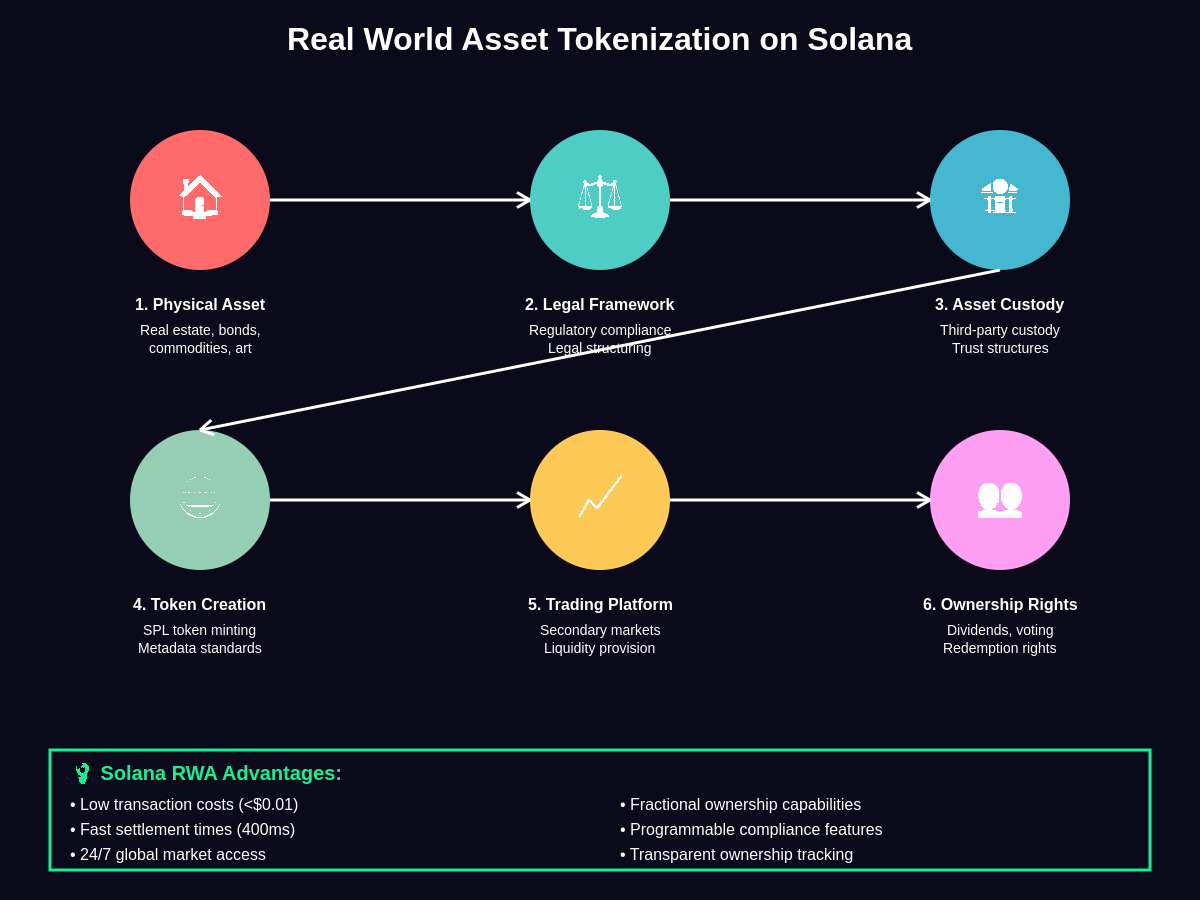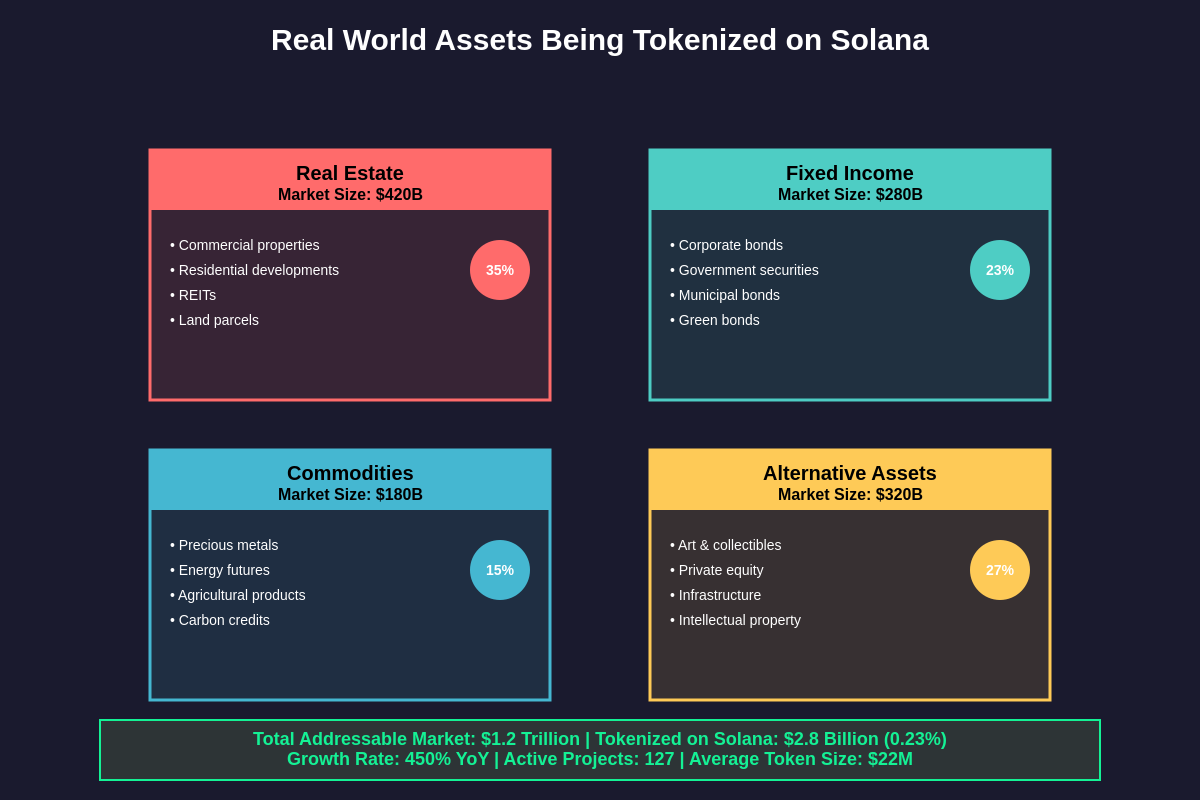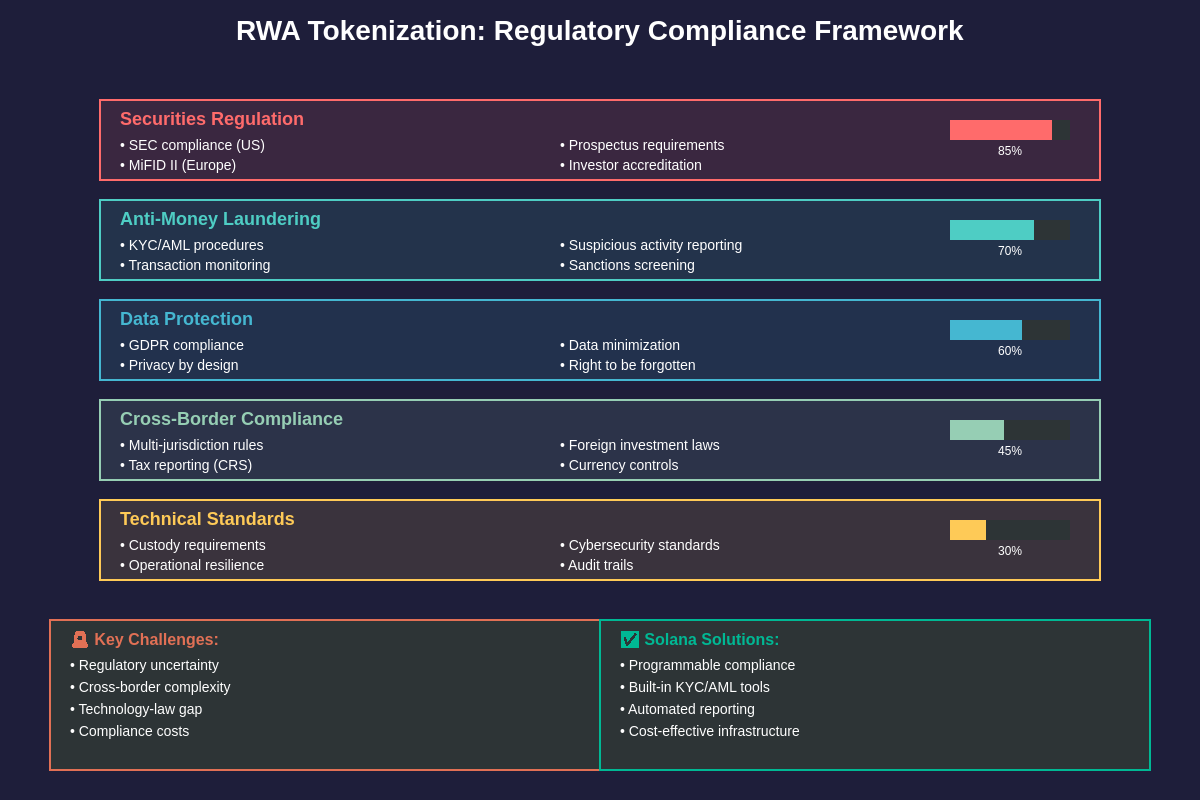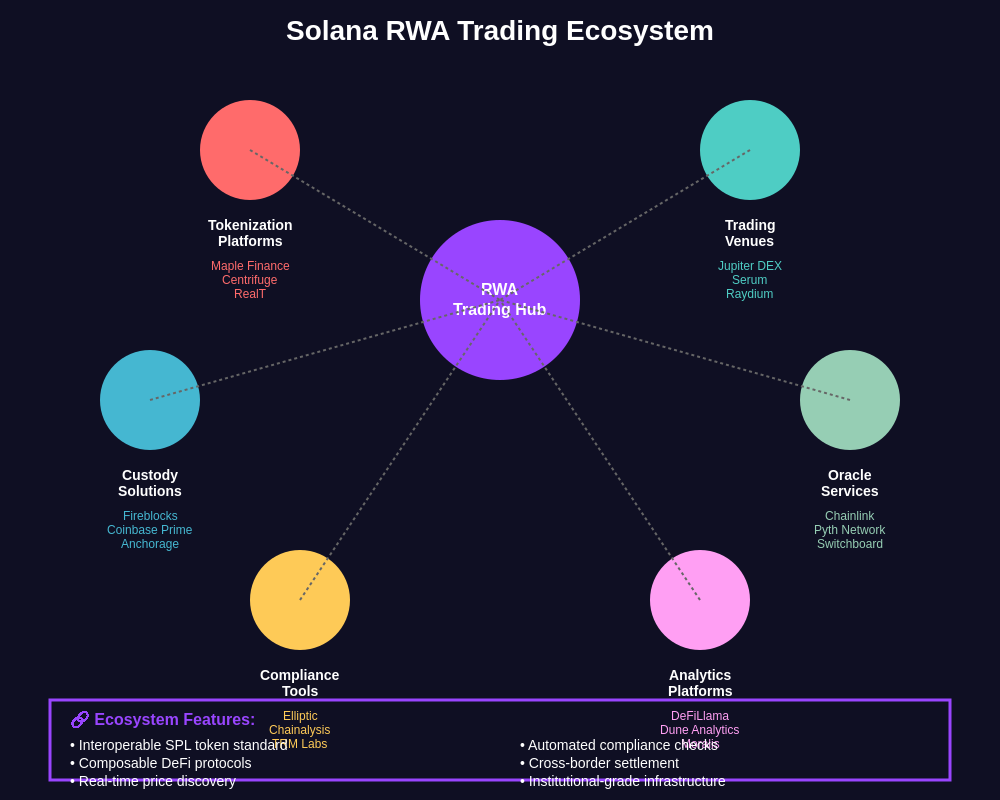Explore advanced trading tools and RWA tokenization opportunities on TradingView
The Revolutionary Convergence of Traditional Finance and Blockchain Technology
The tokenization of real world assets represents one of the most significant developments in blockchain technology, with Solana emerging as the leading platform for bringing traditional financial instruments onto the blockchain. Real world asset tokenization transforms physical and intangible assets into digital tokens that can be traded, divided, and managed on blockchain networks, fundamentally changing how we think about ownership, liquidity, and access to investment opportunities.

Solana’s unique architecture makes it particularly well-suited for real world asset tokenization, offering the speed, scalability, and cost-effectiveness required to handle the complex requirements of traditional financial markets. The network’s ability to process thousands of transactions per second at minimal cost addresses the fundamental barriers that have prevented widespread adoption of tokenized assets on other blockchain platforms.
The real world asset tokenization market has experienced explosive growth, with the total value of tokenized assets reaching over $2.8 billion on Solana alone, representing just a fraction of the estimated $1.2 trillion addressable market for asset tokenization globally. This growth is driven by the compelling benefits that tokenization offers to both asset owners and investors, including increased liquidity, fractional ownership capabilities, 24/7 trading access, and reduced intermediary costs.
Understanding Real World Asset Tokenization Fundamentals
Real world asset tokenization involves the creation of digital tokens that represent ownership rights or economic interests in physical or intangible assets that exist outside the blockchain ecosystem. This process requires sophisticated coordination between legal frameworks, technical infrastructure, and regulatory compliance to ensure that tokenized assets maintain their underlying value proposition while benefiting from blockchain technology’s advantages.
The tokenization process begins with the identification and valuation of assets suitable for blockchain representation, ranging from real estate properties and corporate bonds to commodities, art, and intellectual property rights. Each asset type presents unique challenges in terms of legal structuring, custody arrangements, and regulatory compliance, requiring specialized expertise to navigate the complex intersection of traditional finance and blockchain technology.
Asset custody represents a critical component of the tokenization process, with most tokenized assets requiring third-party custodians or trust structures to hold the underlying physical assets while tokens represent ownership interests. These custody arrangements must comply with relevant regulatory frameworks while providing the transparency and security that blockchain-based ownership systems require.
The legal framework surrounding tokenized assets varies significantly across jurisdictions, with regulatory bodies worldwide still developing comprehensive approaches to digital asset regulation. Successful tokenization projects must navigate securities regulations, anti-money laundering requirements, tax implications, and cross-border compliance issues while maintaining the flexibility and efficiency that makes tokenization attractive.
Solana’s Technical Advantages for Asset Tokenization
Solana’s architecture provides several key advantages that make it particularly suitable for real world asset tokenization compared to other blockchain platforms. The network’s high throughput capacity, with theoretical performance of up to 65,000 transactions per second, ensures that tokenized asset trading can occur at the scale and speed required by institutional investors and high-frequency trading applications.
Transaction costs on Solana average less than $0.01, making it economically feasible to tokenize and trade smaller asset denominations that would be prohibitively expensive on networks with higher fees. This cost efficiency enables fractional ownership models that can democratize access to traditionally illiquid or high-value assets, allowing smaller investors to participate in markets previously reserved for institutional players.
The Solana Program Library (SPL) token standard provides a robust framework for creating tokenized assets with built-in features for compliance, governance, and rights management. SPL tokens can incorporate sophisticated logic for dividend distributions, voting rights, redemption mechanisms, and regulatory compliance checks, enabling complex financial instruments to be represented accurately on the blockchain.
Smart contract capabilities on Solana enable the automation of many processes traditionally handled by intermediaries, including compliance checks, payment distributions, and ownership transfers. Analyze tokenized asset price movements and market trends with professional charting tools These automated processes reduce operational costs, minimize human error, and increase the speed of settlement while maintaining the transparency and auditability that institutional investors require.
Major Asset Classes Being Tokenized on Solana
Real estate represents the largest category of tokenized assets on Solana, with over $420 billion in global real estate value being targeted for tokenization by various platforms.

Commercial real estate tokenization enables property owners to access liquidity without traditional sale processes while allowing investors to gain exposure to high-quality real estate assets with lower minimum investments and greater flexibility.
Residential real estate tokenization has gained particular traction in markets with high property values, where fractional ownership models enable local residents to invest in their communities while providing property developers with alternative funding sources. Real estate investment trusts (REITs) are increasingly exploring tokenization as a way to enhance liquidity and reduce administrative costs while maintaining regulatory compliance.
Fixed income securities, including corporate bonds, government securities, and municipal bonds, represent a rapidly growing category of tokenized assets on Solana. The programmable nature of blockchain tokens enables the automation of interest payments, maturity dates, and credit risk assessments while providing transparent and immutable records of ownership and transaction history.
Green bonds and sustainability-linked securities have found particular success in tokenized formats, as blockchain technology enables more granular tracking of environmental impact and use of proceeds. This transparency appeals to ESG-focused investors who require detailed reporting on the environmental and social outcomes of their investments.
Commodity tokenization on Solana includes precious metals, energy futures, agricultural products, and carbon credits, with each commodity type presenting unique challenges in terms of storage, verification, and delivery mechanisms. Precious metals tokenization has proven particularly successful, with several platforms offering gold and silver-backed tokens that provide investors with exposure to commodity prices without the complexities of physical storage.
Alternative assets including art, collectibles, private equity stakes, and intellectual property rights are increasingly being tokenized on Solana, opening new avenues for investment and liquidity in traditionally illiquid markets. Art tokenization enables collectors to monetize portions of their collections while allowing art investors to diversify across multiple pieces and artists with smaller capital commitments.
The Regulatory Landscape and Compliance Framework
The regulatory environment for tokenized real world assets continues to evolve rapidly, with financial regulators worldwide developing frameworks to address the unique characteristics of blockchain-based securities.

Securities and Exchange Commission (SEC) guidance in the United States has established that many tokenized assets qualify as securities and must comply with existing securities regulations, including registration requirements, disclosure obligations, and investor protection measures.
European regulations under the Markets in Financial Instruments Directive (MiFID II) and the proposed Markets in Crypto-Assets (MiCA) regulation provide additional guidance for tokenized asset offerings in European Union jurisdictions. These regulatory frameworks emphasize investor protection, market integrity, and operational resilience while recognizing the potential benefits of blockchain technology for financial markets.
Anti-money laundering (AML) and know-your-customer (KYC) compliance represent critical requirements for tokenized asset platforms, with most jurisdictions requiring comprehensive identity verification, transaction monitoring, and suspicious activity reporting. Solana-based platforms have developed sophisticated compliance tools that can automatically enforce these requirements while maintaining user privacy and operational efficiency.
Cross-border regulatory compliance presents particular challenges for tokenized asset platforms, as different jurisdictions may have conflicting requirements for the same tokenized asset. Successful platforms must implement flexible compliance frameworks that can adapt to multiple regulatory regimes while maintaining consistent user experiences and operational efficiency.
The regulatory landscape continues to evolve, with many jurisdictions considering specialized frameworks for digital assets that could provide greater clarity and reduced compliance burdens for tokenized asset platforms. Industry participants actively engage with regulators to shape these developing frameworks and ensure that new regulations support innovation while maintaining appropriate investor protections.
Trading Infrastructure and Market Making
Secondary market trading infrastructure for tokenized real world assets on Solana has developed rapidly, with decentralized exchanges (DEXs) and automated market makers (AMMs) providing liquidity and price discovery for tokenized assets.

Jupiter aggregator and Serum DEX represent the primary trading venues for tokenized assets, offering institutional-grade trading tools and deep liquidity pools.
Market making for tokenized assets presents unique challenges compared to traditional cryptocurrency trading, as the underlying assets may have limited price discovery mechanisms or may trade in different time zones or markets. Professional market makers have developed specialized strategies for tokenized assets that account for these factors while providing consistent liquidity and tight bid-ask spreads.
Order book dynamics for tokenized assets often reflect the characteristics of their underlying markets, with real estate tokens typically exhibiting lower volatility and longer holding periods compared to commodity or fixed income tokens. Trading platforms have adapted their interfaces and analytical tools to accommodate these different trading patterns and investor preferences.
Price discovery mechanisms for tokenized assets rely on a combination of underlying asset valuations, market demand, and arbitrage opportunities between tokenized and traditional markets. Oracle services provide critical pricing data for complex assets, while automated rebalancing mechanisms help maintain price alignment between tokens and their underlying assets.
Institutional trading infrastructure on Solana includes advanced order types, dark pools, and portfolio management tools designed to meet the sophisticated requirements of professional asset managers and high-net-worth investors. These platforms integrate with traditional finance systems to provide seamless workflows for institutions transitioning from traditional asset management to tokenized alternatives.
Yield Generation and Income Distribution Mechanisms
Tokenized real world assets on Solana often generate income through various mechanisms including rental payments, interest distributions, dividend payments, and capital appreciation, requiring sophisticated systems for tracking and distributing these payments to token holders. Smart contracts automate many of these processes, ensuring accurate and timely distribution of income based on token ownership percentages.
Real estate tokens typically generate income through rental payments from underlying properties, with income distribution occurring monthly or quarterly based on property performance and occupancy rates. Track real estate and commodity price correlations using advanced market analysis tools Automated distribution systems ensure that income reaches token holders promptly while maintaining detailed records for tax reporting and regulatory compliance.
Fixed income tokens generate predictable income streams through interest payments, with smart contracts automatically calculating and distributing payments based on coupon rates and payment schedules. Variable rate instruments adjust payments based on reference rates or underlying asset performance, with oracle systems providing accurate rate data for payment calculations.
Commodity tokens may generate income through storage fees, financing charges, or futures contango/backwardation effects, depending on the specific commodity and tokenization structure. Carbon credit tokens generate value through environmental impact verification and trading in carbon markets, with blockchain technology providing transparent tracking of credit creation and retirement.
Staking and yield farming opportunities for tokenized assets provide additional income generation mechanisms, with token holders able to earn rewards for providing liquidity to trading pools or participating in governance activities. These yield generation strategies must be carefully balanced against the underlying asset’s risk profile and regulatory requirements.
Institutional Adoption and Infrastructure Development
Institutional adoption of tokenized real world assets on Solana has accelerated significantly, with traditional asset managers, pension funds, and insurance companies beginning to allocate capital to tokenized asset strategies. Major financial institutions are developing internal capabilities for tokenized asset management while partnering with specialized platforms to access tokenization technology and expertise.
Custody solutions for institutional investors have evolved to meet the sophisticated requirements of traditional finance while leveraging blockchain technology’s benefits. Qualified custodians now offer services specifically designed for tokenized assets, including multi-signature security, insurance coverage, and regulatory compliance monitoring.
Portfolio management systems have integrated tokenized asset capabilities, enabling institutional investors to manage tokenized and traditional assets within unified platforms. These systems provide risk management, performance reporting, and compliance monitoring tools designed specifically for the unique characteristics of tokenized assets.
Prime brokerage services for tokenized assets include securities lending, margin financing, and cross-asset collateral management, enabling institutional investors to implement sophisticated trading strategies while maintaining operational efficiency. These services require specialized expertise in both traditional finance and blockchain technology to deliver institutional-quality execution.
Regulatory reporting and tax compliance systems have been developed to handle the complex requirements of tokenized asset investments, including real-time position reporting, automated tax calculation, and regulatory filing preparation. These systems integrate with traditional compliance infrastructure while providing the additional transparency and auditability that blockchain technology enables.
Technology Integration and Interoperability
Cross-chain bridge technology enables tokenized assets created on Solana to interact with other blockchain networks, expanding the potential market reach and liquidity sources for tokenized assets. These bridges must maintain the security and regulatory compliance characteristics of the underlying assets while enabling seamless movement between different blockchain ecosystems.
API integration capabilities allow tokenized asset platforms to connect with traditional financial systems, enabling institutional investors to access tokenized assets through familiar interfaces and workflows. These integrations include portfolio management systems, risk management platforms, and regulatory reporting tools used by traditional asset managers.
Oracle integration provides critical pricing and market data for tokenized assets, ensuring that on-chain valuations remain aligned with underlying asset performance and market conditions. Multiple oracle sources provide redundancy and accuracy verification for critical pricing data, while specialized oracles handle complex asset types with unique valuation requirements.
Interoperability with traditional finance infrastructure includes integration with payment systems, settlement networks, and regulatory reporting platforms used by institutional investors. These integrations enable seamless workflows for institutions adopting tokenized assets while maintaining compliance with existing operational procedures and regulatory requirements.
Data standardization efforts within the tokenized asset ecosystem focus on creating common formats for asset metadata, transaction data, and compliance information. These standards enable better interoperability between different platforms and service providers while reducing integration costs and complexity for market participants.
Risk Management and Security Considerations
Smart contract security represents a critical concern for tokenized real world assets, as vulnerabilities in token contracts could result in loss of funds or disruption of asset ownership records. Professional security auditing services specialize in reviewing tokenized asset contracts, with multiple audit rounds and ongoing monitoring to identify and address potential vulnerabilities.
Custody risk management for tokenized assets requires coordination between blockchain security practices and traditional asset custody procedures. Multi-signature wallets, hardware security modules, and institutional-grade custody solutions provide multiple layers of protection for tokenized asset holdings while maintaining the operational flexibility required for active asset management.
Operational risk management includes business continuity planning, disaster recovery procedures, and operational resilience testing designed to ensure that tokenized asset platforms can maintain operations during adverse conditions. These procedures must account for both blockchain network risks and traditional asset management operational risks.
Regulatory risk management involves continuous monitoring of evolving regulatory requirements and implementation of compliance systems that can adapt to changing regulatory environments. Legal risk assessment includes evaluation of the enforceability of tokenized asset rights and the potential impact of regulatory changes on existing tokenized asset structures.
Counterparty risk assessment for tokenized assets includes evaluation of asset custodians, service providers, and technology partners involved in the tokenization ecosystem. Due diligence procedures must assess both traditional finance capabilities and blockchain technology expertise to ensure that all ecosystem participants can fulfill their obligations to token holders.
Market Impact and Economic Implications
The tokenization of real world assets on Solana is reshaping traditional finance markets by increasing liquidity, reducing transaction costs, and enabling new forms of fractional ownership that were previously impractical or impossible. This transformation has implications for asset pricing, market efficiency, and the distribution of investment opportunities across different investor segments.
Liquidity improvements from tokenization enable asset owners to access capital more quickly and efficiently than traditional sale processes, while investors benefit from increased trading opportunities and reduced holding period requirements. This enhanced liquidity typically results in higher asset valuations and more efficient price discovery mechanisms.
Transaction cost reductions from blockchain automation and reduced intermediary involvement make smaller transactions economically viable, enabling fractional ownership models that can democratize access to high-value assets. These cost savings benefit both asset owners and investors while enabling new business models and investment strategies.
Market efficiency improvements from transparent pricing, automated settlement, and reduced information asymmetries contribute to more accurate asset valuations and better capital allocation. Access comprehensive market data and analysis tools for tokenized assets Blockchain technology’s transparency and immutability provide investors with better information about asset performance and ownership history.
Cross-border investment facilitation through tokenized assets reduces barriers to international investment while providing consistent regulatory frameworks across multiple jurisdictions. This global accessibility increases the potential investor base for tokenized assets while enabling more efficient international capital flows.
Future Developments and Innovation Pipeline
Central bank digital currencies (CBDCs) integration with tokenized real world assets represents a significant future development that could enhance settlement efficiency and reduce counterparty risk for tokenized asset transactions. Several central banks are exploring CBDC implementations that would support programmable money features designed specifically for tokenized asset use cases.
Artificial intelligence integration for tokenized asset management includes automated portfolio optimization, risk assessment, and compliance monitoring systems that can analyze vast amounts of market data and regulatory requirements to optimize investment outcomes. Machine learning algorithms are being developed to identify investment opportunities and risk factors specific to tokenized asset markets.
Internet of Things (IoT) integration enables real-time monitoring and verification of physical assets underlying tokenized representations, providing investors with continuous updates on asset condition, utilization, and performance. This integration is particularly valuable for real estate, infrastructure, and commodity tokenization where physical asset monitoring enhances investment transparency.
Decentralized autonomous organization (DAO) governance structures for tokenized assets enable token holders to participate directly in asset management decisions while maintaining professional oversight and regulatory compliance. These governance models are being refined to balance democratic participation with the expertise and fiduciary responsibilities required for professional asset management.
Layer 2 scaling solutions and sidechains specifically designed for tokenized assets could provide additional performance and cost advantages while maintaining interoperability with the main Solana network. These solutions are being developed to handle specialized requirements of different asset classes while maintaining the security and regulatory compliance characteristics of the underlying assets.
Global Market Expansion and Accessibility
International market access through tokenized assets enables investors worldwide to participate in previously inaccessible investment opportunities while providing asset owners with global capital sources. This expansion requires careful navigation of different regulatory frameworks, tax regimes, and market structures across multiple jurisdictions.
Emerging market integration represents a significant opportunity for tokenized assets, as blockchain technology can provide infrastructure for sophisticated financial instruments in regions with less developed traditional finance systems. Tokenization can enable access to international capital markets while maintaining local ownership and control of underlying assets.
Currency integration and foreign exchange management for tokenized assets require sophisticated systems for handling multi-currency investments, hedging strategies, and cross-border settlement. Stablecoin integration provides mechanisms for reducing currency risk while maintaining the benefits of blockchain-based settlement and management.
Regulatory harmonization efforts across multiple jurisdictions aim to create consistent frameworks for tokenized assets that can facilitate cross-border investment while maintaining appropriate investor protections. Industry organizations and regulatory bodies are working together to develop common standards and mutual recognition agreements for tokenized asset regulations.
Cultural and linguistic adaptation of tokenized asset platforms ensures that global investors can access and understand tokenized investment opportunities while complying with local regulatory and cultural requirements. These adaptations include translated interfaces, local customer support, and culturally appropriate marketing and educational materials.
Environmental and Social Impact Considerations
Environmental, social, and governance (ESG) integration in tokenized assets enables more granular tracking and reporting of sustainability metrics compared to traditional investment approaches. Blockchain technology’s transparency allows investors to monitor the environmental and social impact of their investments in real-time while ensuring that ESG commitments are verifiable and immutable.
Green finance applications of tokenized assets include carbon credit trading, renewable energy project financing, and sustainable real estate development, with blockchain technology providing transparent tracking of environmental benefits and impact measurement. These applications appeal to investors seeking both financial returns and positive environmental outcomes.
Social impact measurement for tokenized assets includes tracking of community development outcomes, job creation, and social benefit delivery for investments in housing, infrastructure, and community development projects. Blockchain-based impact tracking provides investors with verifiable data about the social outcomes of their investments.
Governance improvements through tokenization include enhanced transparency in decision-making processes, more democratic participation in asset management decisions, and better accountability for asset managers and service providers. Token-based voting systems enable proportional representation while maintaining professional oversight and fiduciary responsibilities.
Sustainable finance regulations increasingly require detailed ESG reporting and impact measurement, areas where blockchain technology’s transparency and immutability provide significant advantages over traditional reporting systems. Tokenized assets can automate much of this reporting while providing investors with continuous access to ESG performance data.
The Path Forward for Solana RWA Tokenization
The future of real world asset tokenization on Solana appears exceptionally promising, with continued technological development, regulatory clarity, and institutional adoption driving rapid growth in tokenized asset markets. The combination of Solana’s technical capabilities, growing regulatory acceptance, and increasing institutional interest suggests that tokenized assets will become a significant component of global financial markets.
Technological advancement continues to address remaining barriers to widespread tokenization adoption, including scalability improvements, enhanced security features, and better integration with traditional finance infrastructure. These developments are making tokenized assets more accessible and practical for a broader range of investors and asset types.
Regulatory development is providing greater clarity and certainty for tokenized asset markets, with comprehensive frameworks emerging that balance innovation support with appropriate investor protection. This regulatory evolution is essential for institutional adoption and mainstream acceptance of tokenized assets as a legitimate investment category.
Market infrastructure development is creating the professional-grade systems and services required for large-scale institutional participation in tokenized asset markets. These developments include custody solutions, trading platforms, risk management systems, and compliance tools designed specifically for the unique requirements of tokenized assets.
The convergence of traditional finance expertise with blockchain technology innovation is creating new opportunities for improving investment efficiency, accessibility, and transparency while maintaining the reliability and regulatory compliance that institutional investors require. This convergence positions Solana as the leading platform for the next generation of financial market innovation.
Disclaimer: This article is for informational purposes only and does not constitute financial advice. Cryptocurrency and tokenized asset investments carry significant risks, including the potential for total loss of capital. The tokenized asset market is highly speculative and subject to extreme volatility. Regulatory frameworks for tokenized assets are still developing and may change significantly. Always conduct your own research and consult with qualified financial advisors before making investment decisions. Past performance does not guarantee future results. The author and publisher are not responsible for any investment losses that may result from the use of this information.